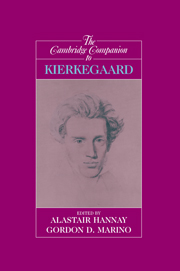Book contents
- Frontmatter
- Introduction
- 1 Out with It!
- 2 The unknown Kierkegaard
- 3 Art in an age of reflection
- 4 Kierkegaard and Hegel
- 5 Neither either nor or
- 6 Realism and antirealism in Kierkegaard's Concluding Unscientific Postscript
- 7 Existence, emotion, and virtue
- 8 Faith and the Kierkegaardian leap
- 9 Arminian edification
- 10 “Developing” Fear and Trembling
- 11 Repetition
- 12 Anxiety in The Concept of Anxiety
- 13 Kierkegaard and the variety of despair
- 14 Kierkegaard's Christian ethics
- 15 Religious dialectics and Christology
- 16 The utilitarian self and the "useless" passion of faith
- Bibliography
- Index
11 - Repetition
Getting the world back
Published online by Cambridge University Press: 28 May 2006
- Frontmatter
- Introduction
- 1 Out with It!
- 2 The unknown Kierkegaard
- 3 Art in an age of reflection
- 4 Kierkegaard and Hegel
- 5 Neither either nor or
- 6 Realism and antirealism in Kierkegaard's Concluding Unscientific Postscript
- 7 Existence, emotion, and virtue
- 8 Faith and the Kierkegaardian leap
- 9 Arminian edification
- 10 “Developing” Fear and Trembling
- 11 Repetition
- 12 Anxiety in The Concept of Anxiety
- 13 Kierkegaard and the variety of despair
- 14 Kierkegaard's Christian ethics
- 15 Religious dialectics and Christology
- 16 The utilitarian self and the "useless" passion of faith
- Bibliography
- Index
Summary
Kierkegaard's slim book Repetition was published in 1843 on the same day as Fear and Trembling. Six weeks later he published a discourse on The Book of Job. The theme of sudden loss and wondrous restoration recurs: Abraham must release Isaac and then he gets him back; Job is stripped of his world and then he gets it back. The book Repetition alludes to Job's yearning for his world's return and also depicts the suffering of a young man who has lost his love and yearns for her return. These motifs provide a clue to the concept of repetition. The question posed by Repetition is whether repetition is possible, whether a world or loved one, now lost, can be restored. But unraveling either the text or the concept is not a straightforward task.
PRELIMINARIES
Repetition is written under the pseudonym Constantin Constantius. It gives ample grist for dialectical mills: repetition is paired with kinesis, the Aristotelian “motion” of becoming, and it is marked as “the task of freedom.” We learn that repetition is (paradoxically) both “the interest of metaphysics and the interest on which all metaphysics comes to grief” (R 149). But these remarks are largely undeveloped, and to complicate matters, they are inserted casually, perhaps even ironically, within a book that reads as a puzzling romantic roman à cléef or novella. Theoretical insights float precariously on a complex literary surface. However serious the idea of repetition is for Kierkegaard, in this book it often seems to flicker merely as an artifice or entertainment.
- Type
- Chapter
- Information
- The Cambridge Companion to Kierkegaard , pp. 282 - 307Publisher: Cambridge University PressPrint publication year: 1997
- 2
- Cited by



